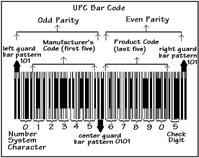








The Universal Product Code (UPC) is a barcode symbology a specific type of barcode. Its most common form, the UPC-A, consists of 12 numerical digits, which are uniquely assigned to each trade item. Along with the related EAN barcode, the UPC is the barcode mainly used for scanning of trade items at the point of sale, per GS1 specifications.UPC data structures are a component of GTINs (Global Trade Item Numbers). All of these data structures follow the global GS1 specification which is based on international standards. Some retailers (clothing, furniture) do not use the GS1 System (other bar code symbologies, other article number systems). Other retailers use the EAN/UPC bar code symbology but without using a GTIN (for products brands sold at such retailers only).
Nearly every product that you buy has a UPC code on it. This is the barcode that cashiers will scan when they are trying to find the price of an item. The barcodes are unique to the item, and they are in use in the US, Canada, UK, Australia, and a number of other countries around the world. The reason for the creation of the barcode was simplicity. The Uniform Grocery Product Code Council was a group of trade associations in the grocery field that were looking for a better way to track products. They met with a number of companies to help them solidify their idea, and they chose a proposal from IBM’s George J. Laurer. The system proved to be extremely effective, and it was first put into action on June 26, 1974. It’s hard to believe that the UPC is still a relatively new invention. The first item that went through the scanner was a 10-pack of Wrigley’s Juicy Fruit Gum, of all things.